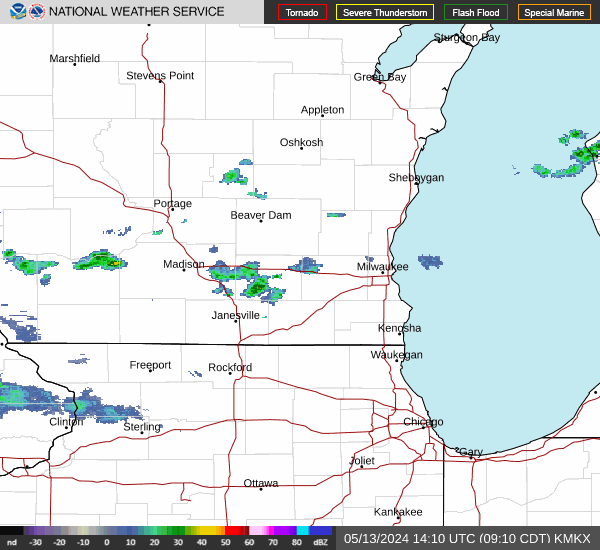Tornado warning issued in Milwaukee County, including Oak Creek and South Milwaukee, after rotations formed
Tornado sirens were heard across Milwaukee County Thursday as the National Weather Service issued a tornado warning for parts of the county.
The warning expired at 5:45 p.m. and areas affected were parts of Milwaukee, Oak Creek, South Milwaukee, Cudahy and Franklin.
"South Milwaukee was kind of in the center of the warning box," said Denny VanCleve, meteorologist with the National Weather Service's Milwaukee office in Sullivan. "So pretty small warning box, and, yeah, I've been hearing and seeing on social media that sirens were going off across the county.
Tornado Warning including Oak Creek WI and South Milwaukee WI until 5:45 PM CDT pic.twitter.com/zOKHutKD3S
— NWS Milwaukee (@NWSMilwaukee) May 16, 2024
"But the warning itself was just south of the airport to about Oak Creek and then west towards Greendale and Franklin. Kind of on the eastern sides of the those towns."
Sirens are typically controlled by local government, and in Milwaukee they are controlled by the County's Office of Emergency Management.
The tornado warning was triggered after NWS observed rotations forming above the county after the storm crossed the lake breeze.
"Sometimes that can be just enough to cause an increase in rotation and then we can see a brief spin up. And so as it crossed lake breeze we did see rotation tighten up and that was enough to pull the trigger on a tornado warning," VanCleve said.
What is the difference between a tornado watch and a tornado warning?
Tornado watch: A tornado watch defines an area where tornadoes and other kinds of severe weather are possible. A tornado watch does not mean tornadoes are imminent, just that everyone should be alert and prepared to go to safe shelter if tornadoes occur.
Tornado warning: A tornado warning means that a tornado has been spotted, or that Doppler radar has detected a thunderstorm capable of producing a tornado. When a tornado warning is issued for your town or county, take immediate safety precautions.
What should I do during a tornado warning?
Here's what to do during a tornado warning, depending on where you're located:
A house with a basement: Avoid windows. Get in the basement and under some kind of sturdy protection such as a heavy table or work bench. Know where very heavy objects are on the floor above, i.e., pianos, refrigerators, waterbeds, etc., and do not go under them. They may fall down through a weakened floor.
A house with no basement, a dorm, or an apartment: Avoid windows. Go to the lowest floor, a small center room like a bathroom or closet, under a stairwell, or in an interior hallway. Crouch as low as possible to the floor, facing down; and cover your head with your hands. Even in an interior room, you should cover yourself with some sort of thick padding (mattress, blankets, etc.), to protect against falling debris in case the roof and ceiling fail.
Office building, hospital, nursing home or skyscraper: Go directly to an enclosed, windowless area in the center of the building, away from glass and on the lowest floor possible. Crouch down and cover your head. Interior stairwells are usually good places to take shelter.
Mobile or manufactured home: "Get out! Even if your home is tied down, it is not as safe as an underground shelter or permanent, sturdy building," according to the Storm Prediction Center. "Go to one of those shelters, or to a nearby permanent structure, using your tornado evacuation plan."
School: Follow the procedures from tornado drills. Go to the interior hall or windowless room in an orderly way. Crouch low, head down, and protect the back of your head with your arms. Stay away from windows and large open rooms like gyms and auditoriums.
Car or truck: Vehicles are extremely risky in a tornado. "There is no safe option when caught in a tornado in a car, just slightly less-dangerous ones," according to the Storm Prediction Center. "If the tornado is visible, far away, and the traffic is light, you may be able to drive out of its path by moving at right angles to the tornado." Park the vehicle out of traffic lanes and seek shelter in a sturdy building or underground if possible. "If you can safely get noticeably lower than the level of the roadway, leave your car and lie in that area, covering your head with your hands," according to the SPC. "Avoid seeking shelter under bridges, which can create deadly traffic hazards while offering little protection against flying debris."
In the open outdoors: If possible, seek shelter in a sturdy building. If not, lie flat and face-down on low ground, protecting the back of your head with your arms. Get as far away from trees and cars as you can; they may be blown onto you in a tornado.
Shopping mall or large store: Move as quickly as possible to an interior bathroom, storage room or other small enclosed area, away from windows.
Church or theater: Move quickly but orderly to an interior bathroom or hallway, away from windows. Crouch face-down and protect your head with your arms. If there is no time to do that, get under the seats or pews, protecting your head with your arms or hands.
Wisconsin weather radar

Wisconsin weather warnings
This article originally appeared on Milwaukee Journal Sentinel: Tornado warning issued for Oak Creek and South Milwaukee has expired
